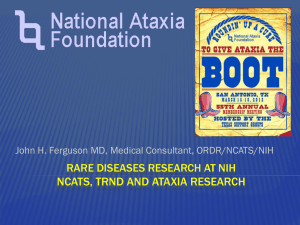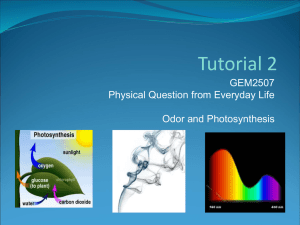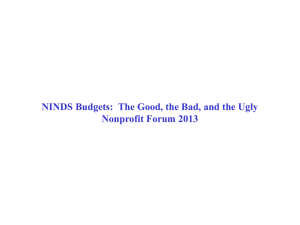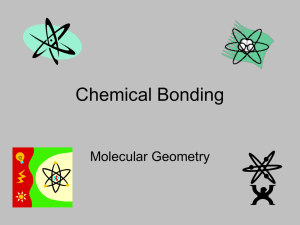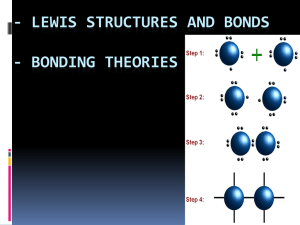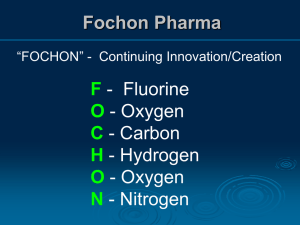Catalyzing Innovation NIH National Center for Advancing
advertisement
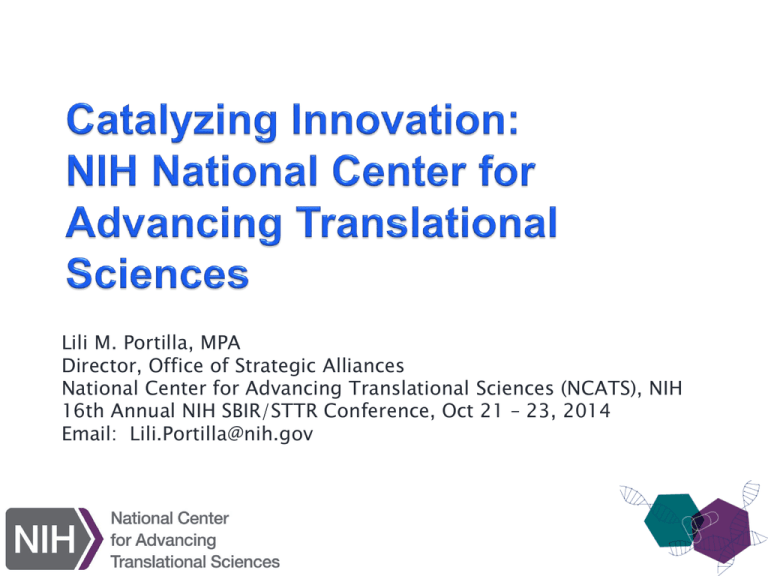
Lili M. Portilla, MPA Director, Office of Strategic Alliances National Center for Advancing Translational Sciences (NCATS), NIH 16th Annual NIH SBIR/STTR Conference, Oct 21 – 23, 2014 Email: Lili.Portilla@nih.gov To catalyze the generation of innovative methods and technologies that will enhance the development, testing, and implementation of diagnostics and therapeutics across a wide range of human diseases and conditions. NCI NHLBI NIAID OD NIDCR NEI NIDA NIA CC NIAMS NIDDK NLM CIT FIC NCATS NHGRI NICHD NIEHS NINDS NIBIB NIAAA NIMH NIDCD CSR NCCAM NINR NIGMS NIMHD Therapeutics for Rare and Neglected Diseases (TRND) Bridging Interventional Development Gaps (BrIDGs) Molecular Libraries Probe Production Center Assay Development Toxicology in the 21st Century (Tox21) DPI currently has 200+ collaborations with investigators across the U.S. and around the world. DPI is administratively intramural No independent PIs, no tenure system All projects are collaborations, 90% of which are with extramural investigators/foundations/companies Projects are selected via solicitation/review Science is intermediary between mechanistic research and commercialization “Adaptor” function Each project has tangible deliverable and technology/paradigm development components It is disease agnostic, works across disease spectrum Common mechanisms and principles to make translation better/faster/cheaper for all Focuses on new technologies, enabling tools, dissemination Activities facilitated through in-house drug development experts and contracts New indications for clinical stage drugs and repurposing approved drugs Medicinal chemistry Rare disease bioassay development Efficacy, pharmacology, ADME, toxicology, PK/PD Compound scale-up, formulation Clinical and regulatory development strategy, natural history studies assessments First in human clinical trials NCATS DPI: A Collaborative Pipeline Founded 2004, as part of MLP ~ 90 scientists collaborations with investigators worldwide Assay development, HTS, chemical informatics, medicinal chemistry: “target to lead” Focus is unprecedented targets, rare/neglected diseases Mission Chemical probes/leads New technologies/paradigms to improve efficiency and success rates of target-to-lead stage of drug development Chemical genomics: general principles of small molecule – target interactions The ADST Laboratory focuses on the development of a more efficient gateway to the drug discovery paradigm through evaluation, development, and refinement of assay strategies and technologies in collaboration with key experts and stakeholders. Create/guide the primary and follow-up assay portfolio needed in the pursuit of therapeutics discovery and development for rare and neglected diseases. Current pilot projects: • Peripheral and Optic neuropathies ―Charcot-Marie-Tooth Disease (CMT) ― Retinitis pigmentosa & Glaucoma • Erythroblastopenia ―Diamond–Blackfan Anemia (DBA) • Parasitic infections • • • Foundations’ gifts CRADAs, RCAs In-kind research support ―Lymphatic filariasis & Onchocerciasis ―Malaria Funding Mechanisms: Highly Collaborative Goal: To formalize this resource through a program/solicitation for assay development for rare and neglected diseases (AD-RND). Toxicology Technology Development: The Tox21 Program • The goal is to quickly and efficiently test whether certain chemical compounds have the potential to disrupt processes in the human body that may lead to adverse health effects. Goals of Program: 1. Identify mechanisms of compound-induced biological activates 2. Prioritize chemicals for more extensive toxicological evaluation 3. Develop predictive models for biological response in humans • Once an assay is approved through a solicitation process, NCATS optimizes, validates, and screens a specially designed library of environmentally relevant compounds; roughly 11,000 compounds are screened by quantitative-High Throughput Screening for each approved assay. Bridging Interventional Development Gaps (BrIDGs) Program Model: Contract access collaboration between DPI and extramural labs (Formerly NIH-RAID Program) Projects Enter with clinical candidate identified Any disease eligible Gap analysis followed by data generation using DPI contracts to generate data necessary for IND filing Exit at or before IND Milestone driven Therapeutic modalities: any (small molecules, peptides, oligonucleotides, gene therapy, antibodies, recombinant proteins) Eligible Applicants Academic (US and Ex-US), Non-Profit, SBIR eligible businesses 180 applications submitted since 2005 34 approved 19 completed projects (two in FY12) 12/12 submitted INDs approved 5 projects in Phase 1, three in Phase II 5 agents licensed during or after BrIDGs involvement Active BrIDGs Projects Applicant Organization Name Org Type Agent Dis Type Funding Au, Jessie Optimum Therapeutics Small business Small Molecule Bankiewicz, Krys University of California San Francisco Academic Gene Vector Bloch, Kenneth Massachusetts General Hospital Academic Small Molecule Darling, Thomas Edunn Biotechnology Small business Oligonucleotide Alzheimer's disease CF/NIA De Leon, Diva Children's Hospital of Philadelphia Academic Peptide Hyperinsulinism Common Fund Donn, Karl Parion Sciences, inc. Small business Small Molecule Chronic dry eye Common Fund Academic Peptide Multiple sclerosis Common Fund Academic* Gene Vector Osteoarthritis Common Fund Dowling, Peter Evans, Chris University of Medicine and Dentistry of New Jersey Beth Israel deaconess Medical Center Pancreatic Cancer Aromatic L-amino acid decarboxylase FOP & Anemia of Inflammation Common Fund CF/NINDS CF/NIAMS/NIDDK Hebel, Henry Terapio Corporation Small business Large Protein Acute Radiation Syndrome CF/NIAID Katz, Laurence University of North Carolina at Chapel Hill Academic* Small Molecule Combination Acute Brain Injury Common Fund Kunos, George NIH/NIAAA Intramural* Small molecule Metabolic syndrome Common Fund MacDonald, Brian Merganser Biotech LLC Small business Peptide Beta Thalassemia CF/NINDS Mannstadt, Michael Massachusetts General Hospital Academic* Peptide Hypoparathyroidism Common Fund Maynard, George Axerion Therapeutics Biologic Spinal Cord Injury CF/NINDS Magruder. Judy Signature Therapeutics Small Molecule Chronic Pain NIDA Mellon, Synthia University of California San Francisco Academic Small Molecule Niemann-pick C CF/NINDS Rogawski, Mike University of California, Davis Academic* Small molecule Epilepsy CF/NINDS Sutula, Thomas University of Wisconsin Madison Academic* Small Molecule Epilepsy Common Fund Turner, Scott Kinemed, Inc. Small business Peptide Atherosclerosis Common Fund Small business Small business * indicates that the investigator is partnered with a company Model: Comprehensive drug development collaboration between DPI and extramural labs with disease-area / target expertise Projects May enter at various stages of preclinical development Disease must meet FDA orphan or WHO neglected tropical disease criteria Taken to stage needed to attract external organization to adopt to complete clinical development/registration, max 2a Milestone driven Therapeutic modalities: small molecules, proteins Serve to develop new generally applicable platform technologies and paradigms Eligible Applicants Academic, Nonprofit, Government Lab, Biotech / Pharma Ex-U.S. applicants accepted 20 projects through pilot phase & 4 public solicitations since 2009 Mix of small molecules and biologics Two innovative platform technologies 3 investigational drugs taken into humans CLL: IND filed with US FDA 7/12/11, approved 8/5/11 SCD: IND filed 10/14/11, approved 11/10/11 Phase 1 trial in patients commenced 9/13/12 Initiated first natural history study Phase I trial commenced 12/11 HIBM: Complete response filed 7/27/12, approved 8/24/12 Phase I trial commenced 9/11 HIBM: NIH Clinical Center, 1st patient enrolled September 2011 Every project is a unique Public-Private partnership Many include foundation and patient advocacy input Therapeutic Area / Disease Sickle Cell Disease Collaborator(s) Agent Status Aes-Rx, NHLBI NME – Small Molecule Clinical Chronic Lymphocytic Leukemia Hereditary Inclusion Body Myopathy Niemann-Pick Type C1 Leukemia & Lymphoma Society, University of Kansas New Zealand Pharmaceuticals, NHGRI Repurposed Drug – Small Molecule NME – Small Molecule Clinical Johnson & Johnson, Albert Einstein College of Medicine, Univ. of Pennsylvania, Washington Univ., NICHD, NINDS , NHGRI Repurposed Drug - Small Molecule Clinical Duchenne Muscular Dystrophy Cryptococcal Meningitis ReveraGen BioPharma NME – Small Molecule Preclinical Viamet Pharmaceuticals, Inc. NME - Small Molecule Preclinical Core Binding Factor Leukemia Autoimmune Pulmonary Alveolar Proteinosis Fibrodysplasia Ossificans Progressiva Schistosomiasis Liu; NHGRI Preclinical Bloch; Massachusetts General Hospital Repurposed Drug - Small Molecule Repurposed Drug Biologic NME - Small Molecule CoNCERT Pharmaceuticals NME – Small Molecule Preclinical Creatine Transporter Defect Lumos Pharma NME - Small Molecule Preclinical Autosomal Dominant Retinitis Pigmentosa (adRP) Hypoparathyroidism Bikam Pharmaceuticals NME - Small Molecule Preclinical Eli Lilly & Co. NME - Small Molecule Preclinical Retinitis Pigmentosa Klassen; University of California - Irvine Cell Based Therapy Preclinical LEOPARD Syndrome Kontaridis;Beth Israel Deaconess Medical Center NME - Small Molecule Preclinical Trapnell; Cincinnati Children’s Hospital Clinical Preclinical Preclinical Intellectual Property • Background IP: Any IP generated PRIOR to initiation of TRND Collaboration are RETAINED by the Applicant as Background IP • New IP: The potential for development of NEW, multi-party IP will depend on the stage at which the project enters into Collaboration with TRND. However, TRND Collaborators should anticipate that there WILL BE joint IP development with NCATS employees. Inventorship: Should NEW IP be generated during the TRND Collaboration, inventorship will be determined according to U.S. patent law Agreements: Various model agreements are available at NIH, through which TRND Collaborations are initiated and governed. The CRADA mechanism is the most commonly used for TRND projects. A CRADA or CRADA Letter of Intent will be expected to be executed before TRND proceeds with the project plan BrIDGs TRND Contract Resource Team-based Collaboration PI must have identified lead agent PI may start with lead optimized No clinical trial support provided Some clinical trial support provided IP retained by owner TRND may generate IP Universal disease scope Rare and neglected diseases only Investigator prepares IND Regulatory affairs assistance provided Projects by Therapeutic Area Projects by Drug Modality CNS Endocrinology Small Hematology & Peptide Cardiopulmonary Infectious Biologic Disease Musculoskeletal Gene Molecule Vector Oncology Projects by Type of Collaborator Academia Government Upon Entry Current Status Discover y Preclinic al IND Enabling IND/Clinic Therapeutics Development Branch Statistics 58 Projects Adopted 7 projects discontinued due to No-Go’s ● 4 clinical trials initiated ● 17 INDs – 100% success rate upon filing w/FDA 34 Ongoing Projects 20 projects completed all requested tasks Website: www.ncats.nih.gov Facebook: facebook.com/ncats.nih.gov Twitter: twitter.com/ncats_nih_gov YouTube: youtube.com/user/ncatsmedia E-Newsletter: ncats.nih.gov/news-andevents/e-news/e-news.html Email us: info@ncats.nih.gov

